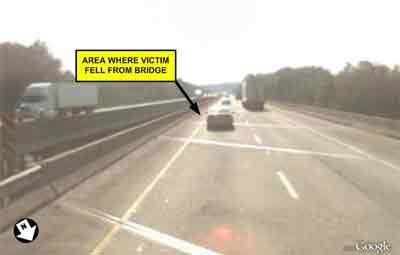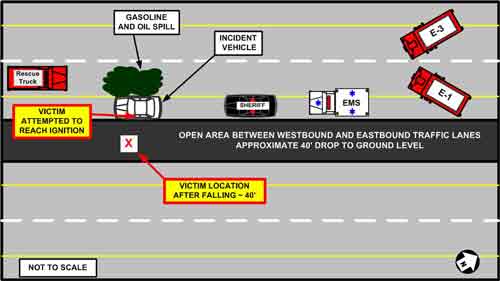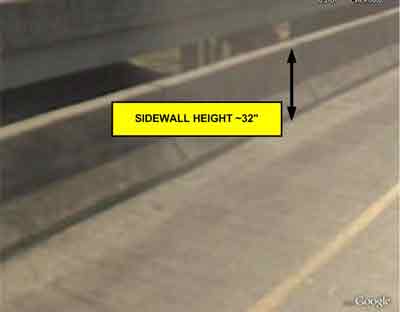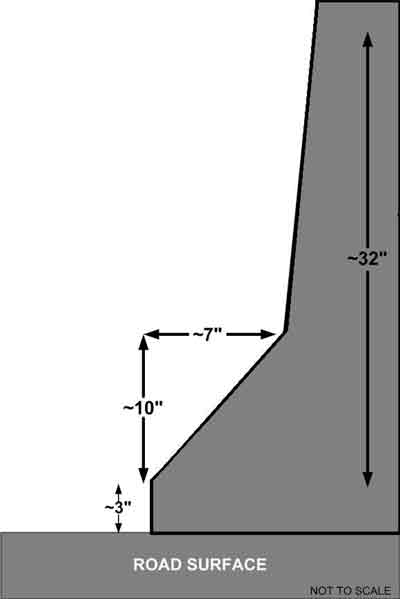Volunteer Lieutenant Dies After Falling From A Bridge While Attending To A Motor Vehicle Crash - Arkansas
 Death in the Line of Duty…A summary of a NIOSH fire fighter fatality investigation
Death in the Line of Duty…A summary of a NIOSH fire fighter fatality investigation
F2007-31 Date Released: October 30, 2009
SUMMARY
On Friday, August 10, 2007, a 39-year-old male volunteer lieutenant fell to his death from an interstate highway bridge while attempting to provide assistance at the scene of a single motor vehicle crash. The crash occurred during the darkness of the early morning hours and the vehicle involved had come to rest against the interstate highway bridge sidewall that bordered the westbound passing lane. The ignition remained in the on position after impact and fluids were leaking onto the roadway. While attempting to remove the keys from the ignition, the victim lost his balance and fell over the bridge sidewall landing approximately 40 feet below the bridge. He was pronounced dead at the scene by the county coroner. Key contributing factors identified in this investigation include fall hazards created by the low sidewall height of roadway bridges and overpasses and possible distorted situational awareness caused by the glare from incident scene lighting.
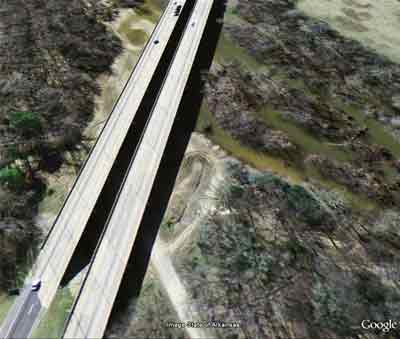 |
|
Aerial view of the interstate bridge where the incident occurred. Depiction from Google Earth. |
NIOSH investigators concluded that, to minimize the risk of similar occurrences, fire departments should:
- ensure that a thorough scene size-up is conducted at all roadway incidents and that risks are assessed and managed throughout the incident
- develop, implement, train on, and enforce standard operating procedures(SOPs) for working near highway bridges and overpasses that include guidance on mitigating fall hazards created by low sidewall height
- develop, implement, train on, and enforce standard operating procedures regarding emergency operations for motor vehicle crashes that include procedures to address the possibility of distorted situational awareness caused by the glare from incident scene lighting
- develop, implement, train on, and enforce standard operating procedures for mitigating motor vehicle crash hazards caused by fuel spills
INTRODUCTION
In the early morning hours of August 10, 2007, a 39-year old male volunteer lieutenant was killed when he fell approximately forty feet from an interstate highway bridge while attending to a motor vehicle crash. On August 10, 2007, the U.S. Fire Administration notified the National Institute for Occupational Safety and Health (NIOSH), Division of Safety Research (DSR) of this incident. On September 4, 2007, an investigation of this incident was conducted by a Safety and Occupational Health Specialist from the NIOSH Fire Fighter Fatality Investigation and Prevention Program. During the course of the investigation the incident scene was visited. Meetings and interviews were conducted with the chief of the department, fire department officers, fire fighters, police, and emergency personnel who were present at the scene, the state police investigating officer, and the fire chief from a neighboring career department who assisted in providing information for the investigation. Copies of the department’s standard operating procedures (SOPs), the victim’s training records, witness statements, death certificate, dispatch records, ambulance run sheet, police report, incident scene diagrams and photographs, were reviewed by the NIOSH investigator.
FIRE DEPARTMENT
The volunteer fire department involved in this incident serves a population of approximately 5,300 residents in an area of approximately 42 square miles of mostly small rural communities and farm land. The department is responsible for approximately 10 miles of interstate highway and responds to an average of 20 – 30 incidents on the interstate per year. The fire department maintains three stations that are staffed by approximately 22 volunteer fire fighting personnel.
TRAINING AND EXPERIENCE
To become a fire fighter in the state of Arkansas, an applicant must take a 16-hour Introduction to Fire course, a 16-hour Protective Equipment course, and an 8-hour Wildland Fire class. Successful completion of all class hours is necessary to receive certification and progress to volunteer status. To become a professional fire fighter, the applicant can apply to the Arkansas Fire Academy once volunteer certification is obtained. The Arkansas Fire Academy is an accredited training program offering standardized curriculum and certification for all professional Arkansas firefighters.
A review of department training records revealed that the lieutenant had completed the required initial training, as well as numerous classes conducted in-house and at the fire academy. Among the many courses he had successfully completed were emergency apparatus operations, first responder, fire origin and cause, vehicle extrication, and rescue operations courses. The victim had been promoted to lieutenant three months prior to the incident, and had served in the same volunteer department for approximately 23 years.
EQUIPMENT, PERSONNEL, CLOTHING AND PERSONAL PROTECTIVE EQUIPMENT (PPE)
Two engines, Engine 1 (E1) and Engine 3 (E3), and a rescue truck (U1) were dispatched from the victim’s department to the scene of the car crash. E1 was driven by the victim, E3 was driven by a captain, and U1 was driven to the scene by the chief of the department. All fire fighters, including the victim, were clothed in turnout pants, t-shirts and boots. No PPE was being worn.
TIMELINE
Note: This timeline is a summary of events that occurred as the incident evolved and not all events are included. All times are approximate and were obtained by reviewing dispatch records, witness statements, and other pertinent information. The emergency response, listed in order of arrival, and events, include:
- 0128 Hours:
A report of a motor vehicle crash with injuries was called in to the county 911 call center. The county sheriff, county fire-rescue (the victim’s volunteer fire department) and emergency medical services (EMS) were dispatched to the incident scene. State police were notified. - 0132 Hours:
The county sheriff arrived on the scene and parked to the rear of the crash vehicle. - 0134 Hours:
The first ambulance arrived on the scene and parked behind the sheriff’s patrol car. - 0137 Hours:
The victim’s fire department radioed dispatch that they were en-route to the scene. - 0140 Hours:
The victim’s fire department, with two engines (E1 driven by the victim and E3 driven by a captain) arrived on the scene. The engines were parked behind the ambulance and blocked both lanes of the highway. The fire chief arrived in the department rescue truck (U1) and parked to the west, and in front of the crash vehicle (Diagram 1). - 0142 Hours:
The sheriff requested state police block the highway on-ramp due to fluids spilling from the crash vehicle. - 0149 Hours:
The sheriff radioed the call center that a fire fighter had fallen off of the bridge and requested the nearby career fire/rescue department be dispatched to the scene to assist. - 0151 Hours:
A second ambulance was dispatched to the scene. - 0152 Hours:
Fire fighters and the sheriff located the victim under the bridge. - 0157 Hours:
The second ambulance arrived on the scene. The sheriff advised the call center that the victim had not survived the fall. - 0159 Hours:
The county coroner and fire department chaplain were notified. - 0235 Hours:
The victim was pronounced dead at the scene by the county coroner.
WEATHER AND ROAD CONDITIONS
The fatality occurred during the night at 0149 hours on a four-lane interstate highway bridge (Photo 1). Police had closed the road and diverted all traffic around the scene. At the time of the incident, the roadway was dry. The ambient air temperature was ~77º, the relative humidity was ~81%, and there was a negligible southwest wind. Neither the weather, nor the road conditions were a factor in the original vehicle crash. Vehicle damage that was caused by impact with the bridge sidewalls, caused fluids, including gasoline and oil, to leak from the car onto the highway. Because of the potential volatility of the fluids, fire fighters were called to spread an absorbent material onto the roadway to soak up the fluids to eliminate a potential fire hazard.
The concrete surface of the bridge where the incident occurred was in good repair. It was approximately 2/10 of a mile in length and spanned a river with an overflow area, which at the time of the incident was dry and rock covered. There were two eastbound and two westbound travel lanes with adjacent shoulders bordered by concrete sidewalls that were approximately 32” in height (Photo 2). These sidewalls were constructed to be wider at the bottom and taper gradually toward the top (Diagram 2). The sloped surface design is intended to assist in preventing a vehicle that has left the travel lane from breaching the sidewall by redirecting the impact force and diverting it back toward the roadway.
The eastbound and westbound lanes were divided by an area that was open to the ground below. The distance from the bridge deck to ground level varied depending on the location but was approximately 40’- 50’ the entire span. The posted speed limit on the interstate highway near the bridge was 70 miles per hour (MPH). There were no highway light fixtures installed in the area that would illuminate the bridge.
INVESTIGATION
On the morning of August 10, 2007 at 0128 hours, a motorist phoned the county 911 call center to report a motor vehicle crash on an interstate highway bridge. Police, fire and EMS units were dispatched to the scene. The county sheriff was the first to arrive and found a single vehicle crash. The driver had self-extricated and was standing at the rear of the wrecked car. While assisting the driver into his patrol car, the officer noticed fluids were beginning to flow onto the roadway from under the passenger side of the car. He advised dispatch to notify the fire department of the fluid spill and requested that state police close down the bridge section of the highway and re-route traffic around the crash scene due to the possible fire and explosion hazard created by the leaking fluids.
E1 and E3 from the victim’s fire department arrived on the scene at 0140 hours and parked behind the crash. Both engines’ headlights were left on to illuminate the scene (Diagram 1). The crashed vehicle was directly adjacent to the south sidewall of the westbound travel lane where it came to rest after first impacting the north sidewall of the bridge. The passenger side door had sustained damage during the initial contact with the north sidewall and the driver’s side door was pinned against the south sidewall. Fluids, which appeared to be gasoline and oil, were leaking from under the car onto the roadway and covering the pavement on the passenger side. As fire fighters advanced toward the car to begin applying the absorbent, they could hear the radio playing and noticed the headlights were on and the keys were still in the ignition. Although there was no discussion among the fire fighters, it is believed that the victim decided to remove the keys in order to mitigate any hazards that could be caused by the ignition being in the on position. As the chief and the driver of E3 began to apply absorbent material onto the roadway to soak up the fluids, the victim headed toward the front of the car. There were no witnesses who saw the victim’s actions right before he fell. It is theorized that as he reached across the car and attempted to remove the keys from the ignition, his movements caused him to be too close to the bridge sidewall and he lost his balance and fell.
The sheriff, who was seated in the patrol car behind the crash vehicle, reported seeing the victim’s boots as he went over the bridge. The chief who was nearby applying the absorbent material to the spill reported hearing a rustling sound and looked up to see the victim just as he fell. The chief called for help and the sheriff and the fire fighters raced to the area under the bridge to search for the victim. He was located within minutes but had not survived the fall. The victim was pronounced dead at the scene, by the county coroner.
CONTRIBUTING FACTORS
Occupational injuries and fatalities are often the result of one or more contributing factors or key events in a larger sequence of events that ultimately result in the injury or fatality. NIOSH investigators identified the following items as key contributing factors in this incident that ultimately led to the fatality:
- Fall hazard created by low bridge sidewall height
- Glare from scene lighting possibly causing inability to maintain situational awareness
CAUSE OF DEATH
The medical examiner listed the cause of death as blunt force injuries due to fall from height.
RECOMMENDATIONS
Recommendation #1: Fire departments should ensure that a thorough scene size-up is conducted at all roadway incidents and that risks are assessed and managed throughout the incident.
Discussion: Incident command should be established at all emergency incidents, including small scale roadway incidents.1,2 The incident commander (IC) should conduct an initial scene size-up, assess all safety and health hazards before emergency operations begin, develop an action plan that addresses hazards to civilians and emergency response personnel, supervise crew members, and re-evaluate risks as the operation proceeds. In this incident, there were several potential safety hazards, including the possible volatility of leaking fluids, fall hazards associated with working on a bridge with a low sidewall, and poor visibility associated with working at night with artificial lighting.
Potential steps to address such hazards include: ensuring that response personnel wear full-turnout gear to protect them in the event of a flash fire in the spill area, deploying protective hose lines or extinguishers for fire control should the spill ignite, applying absorbent materials to control and collect leaking fluids, ensuring adequate and effective scene lighting, and establishing the roadway adjacent to the low side-wall as off-limits through the use of traffic cones or verbal warnings and monitoring.
The risks to fire fighters should be assessed at the initial stages and throughout the incident. For example, in this incident, the fall hazard created by trying to turn off the ignition while reaching into the vehicle from the driver’s side window when it was directly against the low highway sidewall was considerable. Conducting an assessment of all on-scene hazards may have revealed that it was more prudent to delay attempting to turn off the vehicle’s ignition until the spill was controlled and the ignition could be accessed from a less hazardous position.
Recommendation #2: Fire departments should develop, implement, train on, and enforce standard operating procedures (SOPs) for working near highway bridges and overpasses that include guidance on mitigating fall hazards created by low sidewall height.
Discussion: There are numerous safety standards and regulations that provide information and guidance on methods to mitigate fall hazards and protect private sector workers, who work on elevated surfaces.3 These standards require that employees be trained to recognize safety hazards to which they are exposed during the course of their employment. Most safety standards recommend implementing engineering or administrative controls where possible and/or requiring the use of personal protective equipment, which has been specifically designed to mitigate the hazard, when engineering controls are not feasible. However, in most highway emergency scenes fire fighters are called upon to work under extreme conditions and time constraints. There is no time, or very limited time, to engineer-out a hazard and often even recognizing the existence of a hazard can be difficult. In addition to the more familiar roadway dangers, this line-of-duty death provides an opportunity to learn about less recognized emergency scene roadway hazards such as low bridge and overpass sidewall height and glare from incident scene lighting.
When responding to emergency incidents along interstate highway bridges and overpasses, fire fighters may be exposed to fall hazards created by the low height of the sidewalls. According to the American Association of State Highway and Transportation Officials (AASHTO) the lower height of sidewalls on interstate highway bridges and overpasses may be adequate because there is no pedestrian traffic expected.4 Fire fighters and emergency responders who work at incidents adjacent to these sidewalls need to be aware of the fall hazard, and the possible tripping hazard created by the raised and extended sidewall base design (Diagram 2). Departments need to survey their response area, and mutual aid territories, to develop SOPs for specific roadway hazards found within their jurisdiction. If response areas include highway bridges and overpasses, guidance on how to mitigate fall hazards presented by low sidewall heights should be included in department SOPs. Procedures that include repositioning incident vehicles away from sidewalls if possible, and/or utilizing fall protection when feasible and appropriate, should be developed.
To lessen the chance of fire caused by a combination of leaking gasoline and a spark from the car’s engine, it was necessary to gain entry into the wrecked car to turn it off and remove the keys from the ignition. Since entry through the driver’s side door was not possible due to the car’s final location pinned against the sidewall, and the gasoline was leaking adjacent to the passenger door, the victim attempted to access the ignition through the driver’s side window by reaching across the car’s hood. While performing this maneuver the victim’s upper torso would have been parallel with, and higher than, the bridge sidewall. There were no witnesses who saw his movements directly before he fell so it is not known what exactly caused him to lose his balance. Regardless of his position, the low height of the sidewall would not have provided an opportunity for the victim to regain his balance and/or prevent him from falling over the edge.
Recommendation #3: Fire departments should develop, implement, train on, and enforce standard operating procedures regarding emergency operations for motor vehicle crashes that include procedures to address the possibility of distorted situational awareness caused by the glare from incident scene lighting.
Discussion: The Manual on Uniform Traffic Control Devices (MUTCD) provides guidance for departments when they are making traffic incident management plans.5 Section 6D-2, Worker Safety Considerations, cautions workers to ensure that lighting for nighttime work does not cause blinding. Incident scene lighting should be directed at illuminating the operational area where emergency responders are working. High-level lighting that is directed downward on the incident scene is preferable. Ideally, when traffic around the scene is considered secure, and high level lighting is utilized and adequate, forward facing headlights should be turned off and the number of flashing emergency lights should be limited.6 Emergency responders should be made aware that depth perception and situational awareness can be hindered by the glare from incident scene lighting and they should take precautions when working under these conditions.
At the time the victim fell from the bridge, there were five emergency vehicles at the incident scene. They were facing the crash vehicle from both the front and the back. E1 and E2 did not have raised light masts; however, all emergency units at the scene had their headlights and emergency lights illuminated. During his attempt to remove the keys, the victim would have been facing head lights and emergency lights from the crashed car, sheriff’s car, ambulance, and two fire engines. It is possible that the glare from the lights caused him to become disoriented and miscalculate his proximity to the bridge sidewall.
Recommendation #4: Fire departments should develop, implement, train on, and enforce standard operating procedures for mitigating motor vehicle crash hazards caused by fuel spills.
Discussion: A fire hazard exists in motor vehicle crashes where there is a fuel spill or significant risk of spilled fuel. It should be a standard operating procedure to advance a charged hose line close to the damaged vehicle for extinguishment and to help protect the responders and victims, should a post-crash fire occur. Fire suppression should be adequate for the situation and readily available. The line should be at least a 1.5” hose and should be staffed by trained fire fighters in full turnout gear.7 Small fuel spills can usually be handled by using an absorbent material to remove the fuel from the area around the damaged vehicle however larger spills should be handled by qualified personnel such as hazardous material technicians to insure proper mitigation of the hazard.
There are many sources of ignition following a motor vehicle crash that can turn a fuel spill into a fire. A short in the electrical system, an electrical system that remains charged, or a damaged battery may cause a spark that will ignite spilled fuel. Additionally, vapors emitted by a flammable liquid can travel great distances, possibly finding an ignition source and then bring the fire backward igniting the larger pool of spilled fuel.8 Gasoline can even be ignited by the static electricity generated by a responder’s clothing as they approach the spill. In this incident, it was determined that the car’s ignition was in the on position because the headlights were illuminated and the radio could be heard playing. This was an indication that the electrical system remained live. In this type of situation, it is critically important to eliminate any possible source of ignition by turning off and removing the keys from the ignition to eliminate power to the cars electrical system.9 The victim was attempting to remove keys from the car’s ignition when he fell from the bridge.
REFERENCES
- National Fire Protection Association [2007]. NFPA 1500 Standard on fire department occupational safety and health program. 2007 ed. Quincy, MA: National Fire Protection Association.
- US Fire Administration [2008]. Traffic Incident Management Systems. Emmitsburg, MD: Federal Emergency Management Agency, US Fire Administration.
- OSHA. Occupational Safety and Health Administration.29 CFR 1926.760(a)(1) and OSHA 29 CFR 1910.23 Washington, DC; U.S. Department of Labor, Occupational Safety and Health Administration
- American Association of State Highway and Transportation Officials (AASHTO). Guide specifications for bridge railings. Washington, DC; American Association of State Highway and Transportation Officials.
- Manual on Uniform Traffic Control Devicesexternal icon. (MUTCD)[http://mutcd.fhwa.dot.gov]. Date accessed: March 2009.
- Lindsey, J, Patrick, R [2007]. Emergency vehicle operations. Upper Saddle River, NJ: Pearson Prentice Hall, Chapter 9.
- IAFC/NFPA [2004]. Fundamentals of fire fighter skills. Sudbury, MA: International Association of Fire Chiefs/National Fire Protection Association; Jones & Bartlett Publishing.
- IFSTA [2008]. Essentials of fire fighting and fire department operations. 5th ed. Stillwater, OK; Oklahoma State University.
- NFAAA [2000]. The firefighter’s handbook, essentials of firefighting and emergency response. Stamford, CT: National Fire Academy Alumni Association; Delmar Publishing.
INVESTIGATOR INFORMATION
This investigation was conducted, and the report authored by, Virginia Lutz, Safety and Occupational Health Specialist with the NIOSH, Fire Fighter Fatality Investigation and Prevention Program, Surveillance and Field Investigations Branch, Division of Safety Research, NIOSH. An expert review was provided by Jack Sullivan, CSP, CFPS, Director of Training, Emergency Responder Safety Institute.
PHOTOS AND DIAGRAMS
|
The National Institute for Occupational Safety and Health (NIOSH), an institute within the Centers for Disease Control and Prevention (CDC), is the federal agency responsible for conducting research and making recommendations for the prevention of work-related injury and illness. In fiscal year 1998, the Congress appropriated funds to NIOSH to conduct a fire fighter initiative. NIOSH initiated the Fire Fighter Fatality Investigation and Prevention Program to examine deaths of fire fighters in the line of duty so that fire departments, fire fighters, fire service organizations, safety experts and researchers could learn from these incidents. The primary goal of these investigations is for NIOSH to make recommendations to prevent similar occurrences. These NIOSH investigations are intended to reduce or prevent future fire fighter deaths and are completely separate from the rulemaking, enforcement and inspection activities of any other federal or state agency. Under its program, NIOSH investigators interview persons with knowledge of the incident and review available records to develop a description of the conditions and circumstances leading to the deaths in order to provide a context for the agency’s recommendations. The NIOSH summary of these conditions and circumstances in its reports is not intended as a legal statement of facts. This summary, as well as the conclusions and recommendations made by NIOSH, should not be used for the purpose of litigation or the adjudication of any claim. For further information, visit the program website at www.cdc.gov/niosh/fire or call toll free 1-800-CDC-INFO (1-800-232-4636).
|
This page was last updated on 10/30/09.

